House Diary: Beltane
Beltane, AKA May Day, is one of the Cross-Quarter days in the pagan year, the midpoint of Spring. Beltane’s focus is fertility, and in the Old Days, we’d all be out rutting in the fields to encourage a good harvest, not a bad religious tenet when you think about it (though somewhat hard on the back). So Beltane represents the earth’s fecundity, with nature coming into its first exuberant flush of bloom and growth. As such, it’s known for warm, wet days, lots of flowers, and the first bits of fruitfulness, as asparagus, rhubarb, strawberries, and cold-frame lettuces are ready for harvest.
But with climate change running rampant, it’s been an off year. After an unseasonably warm winter with no snow cover, temperatures remained much cooler than average for March and April. This was great for extending the bulb bloom season, but not so great for early plants, which suffered through some frost and even freeze nights in late April and May here in the Lehigh Valley. As I write (May 15), we just had what will hopefully be our final frost warning two nights ago, but today the temps are spiking to 85! Welcome to global warming!
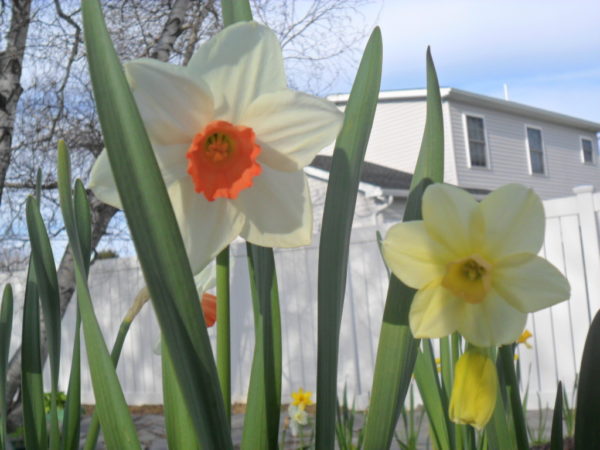
Pink Charm (left) and Bell Song make a bold show in pink in the mid-spring garden; note the bright yellow of Bell Song’s buds, compared to the cream and blush pink of its opened flower
After a promising start on the early bulbs, the late season daffodils were by and large good performers as well. Bell Song was particularly intriguing. It’s a smaller daffodil, about halfway in size between Jetfire and a standard narcissus, which also sports multiple blooms per stem, and gave 2-3 stems per bulb, which is good for a first season. As they budded, I was certain I’d been sent the wrong variety: Bell Song is a pale pink daffodil, but these buds were approaching lemon yellow!
And then they opened, and the show began! As soon as the buds broke, the petals began to pale to a cream color, while the cups, initially a paler yellow, flushed to medium pink. Planted with Pink Charm, a brightly colored pink cup of a more standard size, the contrast was lovely. As Pink Charm ages, it fades to a paler tone, until by the time both varieties have matured, their cups are very similar in color.
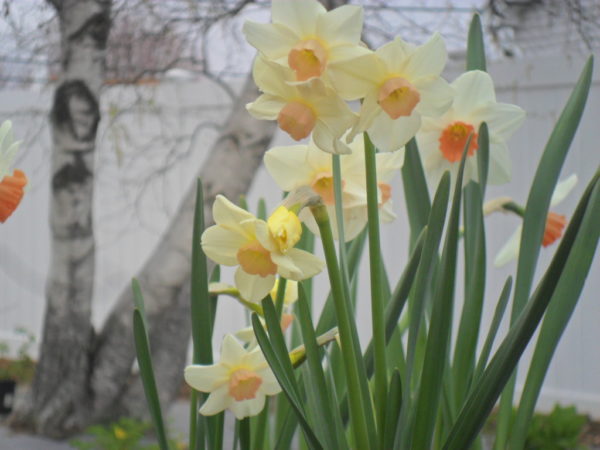
Bell Song in its mature form, multi-flowered and prolific; it was definitely one of the stand-out performers of the season
As noted above, due to the cooler than average temps, the mid-season daffs lingered for weeks longer than normal, and I was still cutting for bouquets as of Beltane Eve. Which is just around the time the lilacs begin to come in.
We used to have many more of these on the property, but the sand mound installation in 2010 took a lot of plant material, including two stunning double-flowered white lilacs. Fortunately spared was the corner planting, which is composed of a single white, a huge French lilac, a standard purple double, and the prize of the garden, an enormous deep burgundy lilac which was started when I was a boy, with a seedling taken from my paternal grandfather’s yard. This is a rare color difficult to obtain these days, and though a bout with straight line winds in early April tore a large section out of the plant, there’s still more than enough to go around.

The stand of lilacs on the southwest corner of the garden; technically it has grown over the property line, so I cut the fence at a 45 degree angle on that corner, and left it outside
Lilacs are notoriously poor performers as cut flowers, due to the woodiness of their stems. You can compensate for this somewhat by crushing them with a hammer, or slicing up the stem for an inch or so from the cut, to allow easier access to water once they are in vases. Their stunning multi-blossom form and pleasing fragrance make it worth the extra effort, and this year while the French and single white varieties faded in a couple days, as is typical, the burgundy variety held on in bouquets for a full week!
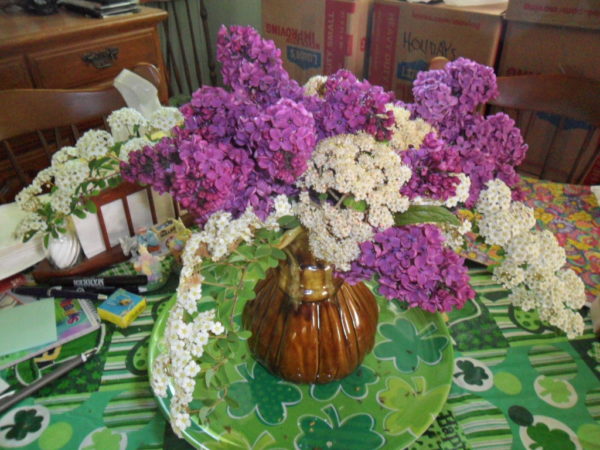
This burgundy lilac marries well in a bouquet with verbena and bridal wreath; the brown vase is one my family has used for lilac bouquets for three generations
Of course, Beltane’s main focus is as a planting season. We aren’t technically frost-free here until after the 15th of May, so tender annuals and herbs will have to be covered or carted back inside on colder nights if potted or unplanted, still in their market packs. But perennials are good to go in late April, and I had a massive order of 75 due in the first week of May.
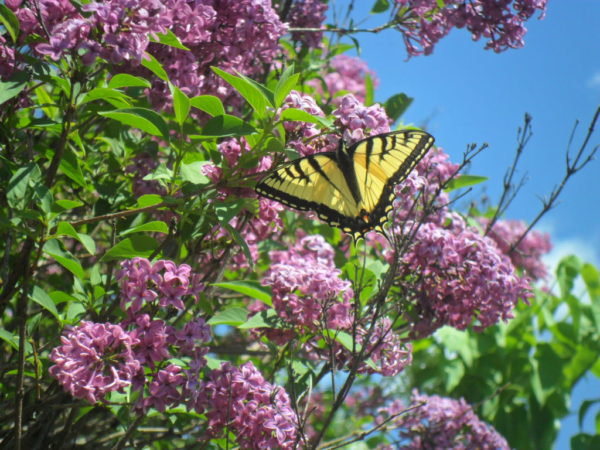
A welcome spring visitor graces the French lilac; it’s early to see a Tiger Swallowtail butterfly in these climes, but the fauna as well as the flora seems thrown off by climate change
I don’t order live plants in the mail anymore, having had numerous bad experiences with this in the past, but bareroot, bulb, and rhizome varieties do well, so I loaded up on these. The order got split in two for shipping purposes, which worked out fine, as all at once it would have been a lot in one day for the crew I had doing the installation.
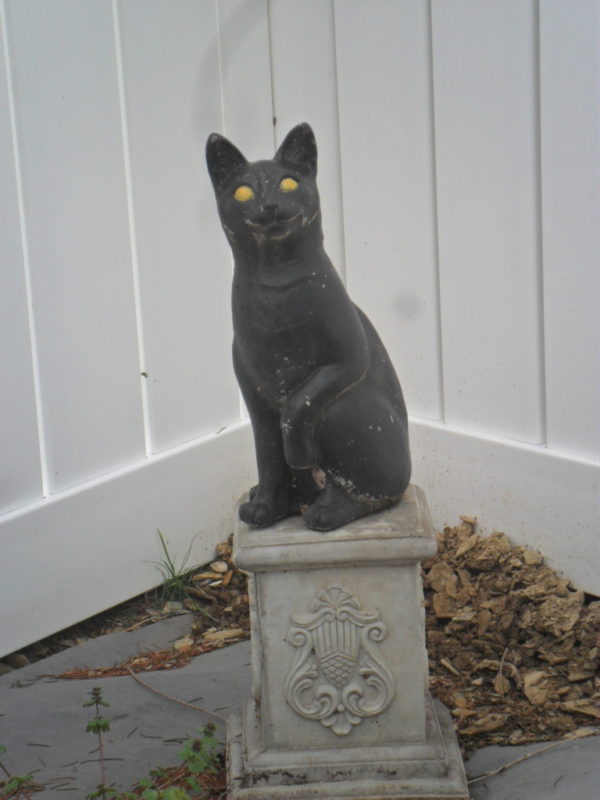
The start of the proposed stray cat shrine, in the garden’s northwest corner; I hope to surround this ebony beauty with ornamental dwarf conifers, but so far, haven’t found any to my liking
So this week we planted heuchera, echinacea, bee balm, perennial sunflower, hollyhock and yet more Asiatic lilies. We also dropped in lots of transplants from the old garden in Philly, hostas, vinca, archangel, ferns, yellow dicentra and jack-in-the-pulpit. Not to mention new purchases from my local perennial farm, principally heliopsis and primula.
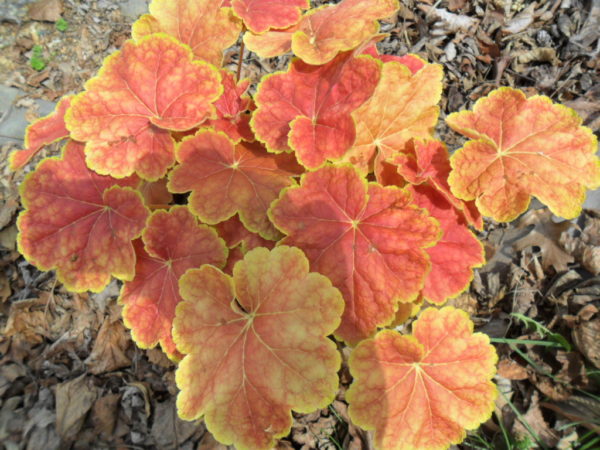
An orange heuchera is one of the plants brought from the Philly garden; the new heucheras came bareroot and won’t be up and showing for weeks
I tend to favor unusual varieties, so my hostas are variegated, green-and-yellow mixes or bluish colors; my heucheras will be shades of purplish-pink, lime, orange-russet and tawny; the hollyhocks are purple-black and my echinacea are in tones of white, yellow and orange, rather than the standard pink of the purple coneflower, most popular of its breed. Still on the way are white bleeding heart, exotic ferns, butterfly weed and crocosmia, among others.

I tend to prefer exotic, unusual varietals, and this yellow hosta with emerald border is one of my all-time favorites for shade
The lilies we planted last fall are of a new strain, dubbed “reblooming”, and they are up and growing, with a heart for any fate. Typically daylilies, as with most perennials, will flower for a 2-3 week period and then the show’s over until next year. But these are purported to bloom all summer; not as vigorously as the first crop, but sending up spikes regularly until frost. I’ll believe THAT when I see it, but again, the colors are so unique and exotic, purples, reds and limes, even if I just get the usual lone bloom season, I’ll be happy so long as they thrive.
And speaking of reblooming, yellow dicentra is a great addition to any garden. It’s a native type of bleeding heart, but with blossoms that look more like bugles than the pendulous heart shapes we’re familiar with, and attractive, almost fernlike leaves. As the name implies, these are yellow, and they truly do bloom throughout the growing season, starting in early May and going right up to frost. Last year mine in Philly remained evergreen over the mild winter, though they stopped blooming in November.
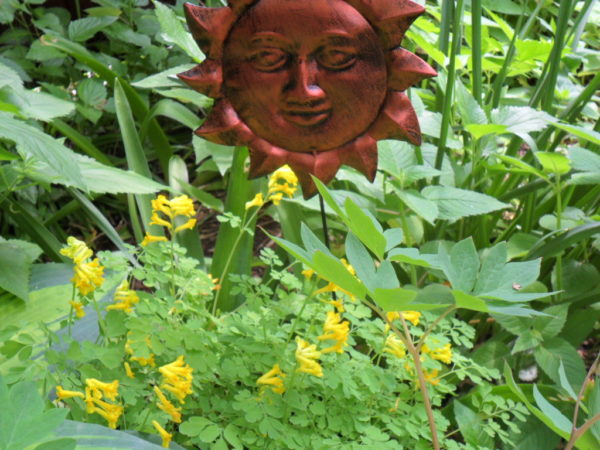
My first yellow dicentra, planted in Philadelphia in 2010; the transplants I brought along this spring are descendants of this initial plant
They do well in most light levels from sun to shade, though if in full sun they tend to burn out a bit at the hottest parts of the summer, and in full shade they don’t bloom prolifically. So I try to plant them in liminal zones, at the edges of tree-shaded areas where the sun’s rays penetrate for only portions of the day as it glides across the sky. They also self-sow readily, a real plus when you’re trying to fill in a large space from scratch, as I’m doing now.

I haven’t grown black hollyhock in many years, but I’m looking forward to its contrast with the perennial sunflower I have planted beside it
Among my favorite perennials is the heliopsis. I’ve cultivated these for almost two decades, usually potted, though they will also sow into the soil around them. Their blooms are electric yellow, prolific, and long-lasting. Even once they fade to white, they’re still attractive for weeks before they take on a more untidy appearance. And they make an excellent dried flower, though their tones fade to parchment over time and they become brittle, sending a shower of petals cascading to the floor when bumped or brushed. This year I’m branching out and also trying some new varieties, in the orange to rust range; we’ll see how they do.
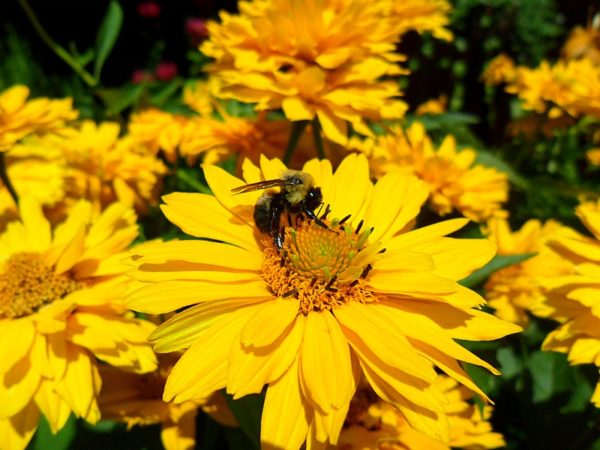
Heliopsis “Summer Sun” has been a favorite of mine for decades; this pic with a bee pollinating it was snapped in 2012
Heliopsis can be tricky about moisture – they tend to wilt a bit at the hottest part of the day, but they don’t like wet feet either, so be careful about how much you water! A gardener’s natural impulse upon seeing wilt is to offer a drink, but I killed a few heliopsis through that perceived kindness before I learned there’s only so much they can take, and the wilt will revive on its own once the sun passes the meridian. I have to confess, however, the sight of a wilting heliopsis still makes me tense, and I have to fight the urge to get out the watering can.

Heliopsis “Bleeding Hearts” is a new varietal I’m trying this year; in the past, these sorts of hybrids haven’t worked out well for me, but hope springs eternal!
It’s been an unusually dry spring along with the cold, a rare combination which can be deadly for young plants. So it’s water, water every day! By the time we get to high summer and the entire garden is planted, I’ll utilize a sprinkler system, but for now it’s the hose and watering cans, and currently, only half planted, it’s still a two-hour job. And my arms are now 3” longer than they were.

The first of the 2020 annuals, intended for showpiece urns and pots; I won’t plant any in the soil until the rest of the perennials are in
It’s a good way to connect with the garden, though, and of course affords the opportunity to pluck out a weed or two while I do my rounds, and closely monitor the progress of bareroot stock as shoots emerge. Which isn’t to say I love and enjoy watering by hand, but it has its compensations.
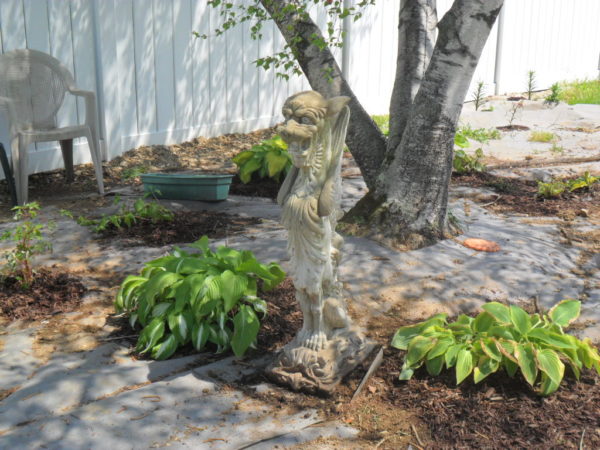
This stone griffin has been a faithful companion for over thirty years, and seems at home in his new resting place with the hostas under the triple birch clump; it’s the first thing you see when you enter the garden gate
Of course, no garden is complete without its statuary! These vital focal points add depth and architectural interest to the landscape, and I’ve collected quite a few pieces over the years. A three-foot griffin which I’ve had since my twenties has followed me everywhere, and a reclining doe which had been my grandmother’s, and then resided in this yard when I was in my teens, after thirty years abroad with me in Philadelphia has now come back to its old haunt.
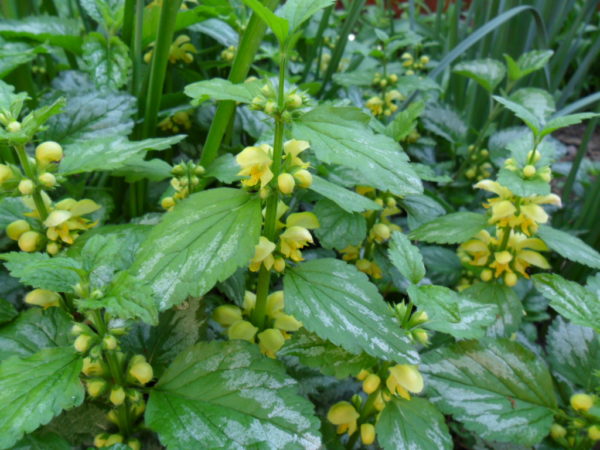
Archangel makes a superb ground cover, doing well in all light levels, but be careful – it’s invasive! The silver and green foliage brightens shady spots all season long, but its true glory comes at Beltane, when it sends spikes of yellow mint-like flowers skyward
The new fence is vinyl, which is pretty maintenance free and endures well, but it’s not the easiest thing to put a nail in, so I’ve had to devise new ways of hanging plaques. A loop of heavy gauge wire does the trick, and I now bless the township’s restriction on true privacy fences, as the ¼ inch separations between slats allow me to loop the wire over the top rail and hang garden décor virtually anywhere along the fencing, not just at the posts. There’s a terra cotta sun and moon, a lion’s head, a disk with a dragonfly and another with hummingbirds, as well as a few smaller pieces. And, of course, my black cat figurine atop its cement pedestal, a tribute to my decade-plus of cat rescue work.
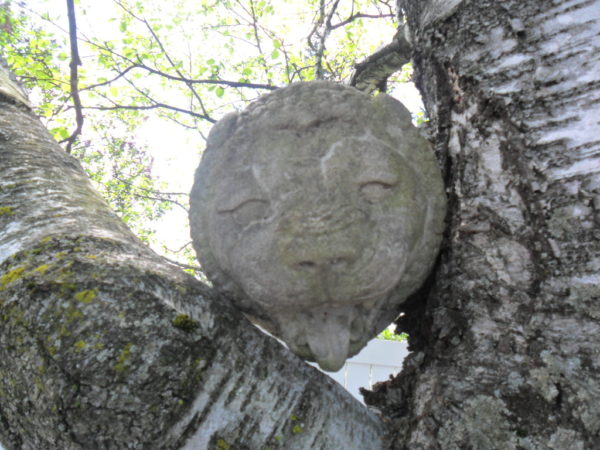
This cement lion head formerly adorned the back stoop of my apartment in Philadelphia, but now finds a cozy nook in the crotch of a Paper Bark birch; both lions and birch are Leo-ruled
I had no Beltane Feast this year per se, due to coronavirus and the move, but my menu typically features a mushroom-leek soup as a starter, spicy with ginger and thick with exotic dried varieties; perhaps a main course of a casserole with chicken, penne pasta, onion, asparagus, ramps (when I can get them!) and a cheese sauce; and of course strawberries and rhubarb for dessert!
I’ve combined these in various forms over the years, from pies to crisps and mousses. It’s an interesting fact (and I hope you’ll agree) that the term “Strawberry Rhubarb” didn’t originally refer to a mix of these flavors. It was a varietal name for the first truly red rhubarb marketed (as opposed to the predominantly green-stalked varieties cultivated in kitchen gardens time out of mind). So when restaurants in the ‘30s began blaring about their “Strawberry Rhubarb Pies”, they meant just a rhubarb filling, but with the new red-colored strain. In time, that distinction became lost, and less-well-informed folks started combining strawberries and rhubarb, and thinking that was the meaning of the phrase all along.
However it transpired, it’s a winning combination! Sweet and tart rolled into one irresistible flavor profile. Though rhubarb solo can be delicious too, and I’m particularly fond of my Rhubarb Mousse, which is actually a variety of Fool. Simply cook down a few cups of rhubarb with a few tablespoons of sugar and water until soft and pulpy; let some of the moisture cook out until the mixture is slightly thickened. Cool completely before refrigerating (to prevent condensation, which will make the base wetter again), chill for several hours or overnight, and then gently fold into a cup of heavy cream beaten to stiff peaks with vanilla and powdered sugar to taste. Voila! Rhubarb Mousse!
If you want a real show-stopper, you can “streak” this with blackberry puree. Again, cook down a pint of blackberries with a little sugar and a touch of water, allow to thicken, then strain to remove seeds. You should have an almost syrupy-like consistency once chilled. Layer this at the edges of a clear goblet or serving dish, so the purplish blackberry layers are visible between the blush pink rhubarb layers. Top with more whipped cream and you have a stunning presentation!
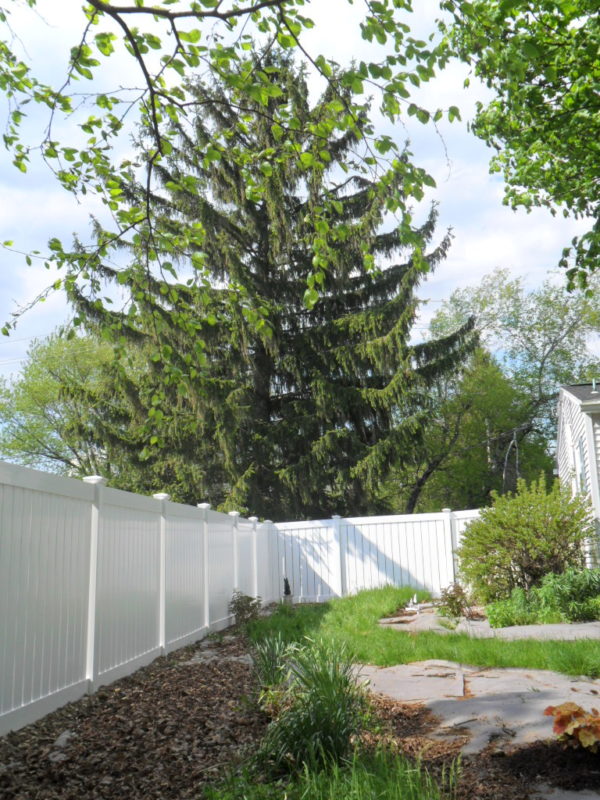
I brought this evergreen home in a paper cup from my Sixth Grade celebration of the second Earth Day, in 1971; I’d say it’s thrived!
It’s been an octave (meaning one of the eightfold segments of the pagan year) of change and transition, with the final move completed and the beginnings of the garden transformation begun. There’s still much to do to finish the metamorphosis, but this is a good start.

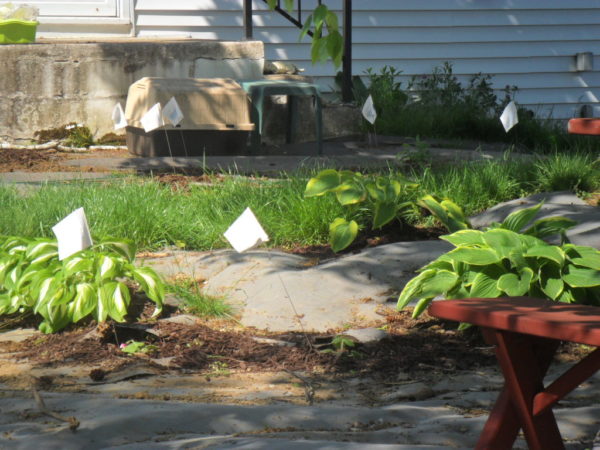



7 comments, add yours.
Marjorie Manifold
Such a lovely – positive! – tribute to the continuation of life. May the promised of spring remind us that even when our vision of the sun is obscured by darkening storms, the sun remains a constant, awaiting to be seen again. Thanks!
litebeing
glorious and quite informative!
Diane Flannagan
Love your garden and your cat statuary. Your flowers are fantastic and your feast mouth-watering except for….the ramps. Happy Cross Quarter to you in your new space.
Jackie Middleton
All Nature sings and round us rings the music of the spheres. Doth not even Nature teach you?
Dixie Gladstone
Alex Miller is a professional gardener and home-loving man extraordinaire! Today he taught me the beauty of a colorful, soulful garden……and that rhubarb blackberry mousse was to die for! Thanks Alex! I live in so. cal., can hardly grow a daffodil as they are dry by the time they’re UP! That is if we’ve had enough rain to get them to come UP. I have a favorite rose called Happy Chappy that grows even in our heat over 100 degrees when summer really sets in. Do you have an asteroid in your chart that corresponds to your green thumb????
Alex Miller
AuthorOnly asteroid Gardner at 3 Leo, conjunct my Sun at 4. :^) and Sunday, a week after the Saturn Station Retro at 1 Aquarius, the well ran dry while I was watering! natal asteroid Wells is at 1 Leo, exactly opposed transit Saturn… could be a long dry summer!
Alexa
Very nice shots, especially the lilacs.
I like the honey bee and I hope you get many pollinators this summer. They are so important for crops, and they need to be nourished in the face of the many pesticides being used. For the stray cat shrine, will you offer any catnip? It’s fun to watch the cats playfully roll around, especially when the catnip has dried.